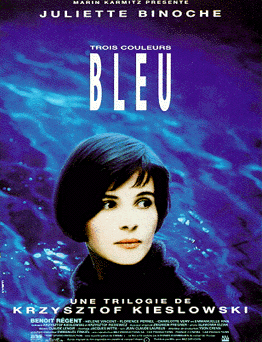
In the dimly lit corners of Paris, the shadows whisper a tale of sorrow, resilience, and the quest for identity. “Three Colors: Blue,” directed by the visionary Krzysztof Kieślowski, is a film that immerses its audience in a profound exploration of grief and rebirth. The movie, the first of the acclaimed Three Colors Trilogy, stars the mesmerizing Juliette Binoche as Julie, a woman who navigates the treacherous waters of loss and rediscovery with a haunting grace.
The story begins with a devastating car crash that shatters Julie’s world, claiming the lives of her husband Patrice, a renowned composer, and their young daughter. In the blink of an eye, Julie is stripped of her family and thrust into an abyss of despair. Binoche’s portrayal of Julie is nothing short of extraordinary; her silent screams and hollow gazes speak volumes about the depth of her pain. The grief is palpable, and Kieślowski’s camera lingers on her expressions, allowing the audience to feel every tremor of her shattered heart.
Determined to sever ties with her past, Julie withdraws from the world, selling her home and moving into an anonymous apartment in Paris. She seeks solace in solitude, attempting to erase her memories and retreat into a void where nothing can hurt her anymore. However, the past has a relentless grip, and Julie finds herself entangled in the unfinished symphony that her husband left behind. The music becomes a haunting presence, a ghost that refuses to be silenced.
Julie’s interactions with the people around her reveal the complexity of human connections. Her former housekeeper, portrayed by Florence Pernel, and her husband’s assistant, played by Emmanuelle Riva, bring fragments of the past that Julie cannot escape. The film’s narrative weaves these characters into Julie’s journey, each encounter a step towards her reluctant acceptance of her history and identity.
Olivier, a family friend and colleague of Patrice, is portrayed by the talented Benoît Régent. His unrequited love for Julie and his dedication to completing Patrice’s symphony symbolize the persistence of life and love, even in the face of overwhelming grief. Olivier’s presence is a beacon, gently guiding Julie towards the realization that detachment is not the answer to her suffering.
The cinematography by Slawomir Idziak bathes the film in shades of blue, a color that signifies both melancholy and transcendence. The blue-tinted visuals create a dreamlike quality, a visual metaphor for Julie’s state of mind. The recurring motif of blue objects – a chandelier, a swimming pool, the sky – punctuates her journey, illustrating the subtle shifts in her emotional landscape.
As the story unfolds, Julie’s journey transforms from one of withdrawal to a path of cautious re-engagement with life. She gradually confronts her grief, and through the power of music, she begins to find a semblance of peace. The unfinished symphony, a symbol of her unresolved past, becomes a conduit for her healing. In completing it, she acknowledges her pain and starts to forge a new identity that embraces both her loss and her future.
“Three Colors: Blue” is a poignant meditation on the human condition, exploring themes of freedom, memory, and the indomitable spirit of resilience. Juliette Binoche’s performance is a masterclass in conveying the unspeakable depths of sorrow and the quiet strength that emerges from it. Kieślowski’s direction, combined with an evocative score by Zbigniew Preisner, crafts a cinematic experience that lingers long after the credits roll.
In the silence that follows the final note of the symphony, Julie stands as a testament to the power of enduring love and the unyielding human spirit. “Three Colors: Blue” is not merely a film; it is a resonant symphony of the soul, a story that speaks to the heart of what it means to be truly alive.
Leave a comment